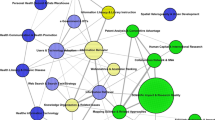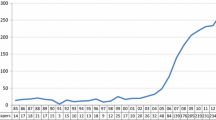Abstract
This study involved using three methods, namely keyword, bibliographic coupling, and co-citation analyses, for tracking the changes of research subjects in library and information science (LIS) during 4 periods (5 years each) between 1995 and 2014. We examined 580 highly cited LIS articles, and the results revealed that the two subjects “information seeking (IS) and information retrieval (IR)” and “bibliometrics” appeared in all 4 phases. However, a decreasing trend was observed in the percentage of articles related to IS and IR, whereas an increasing trend was identified in the percentage of articles focusing on bibliometrics. Particularly, in the 3rd phase (2005–2009), the proportion of articles on bibliometrics exceeded 80 %, indicating that bibliometrics became predominant. Combining various methods to explore research trends in certain disciplines facilitates a deeper understanding for researchers of the development of disciplines.
Similar content being viewed by others
References
Åström, F. (2002). Visualizing library and information science concept spaces through keyword and citation based maps and clusters. In H. Bruce, R. Fidel, P. Ingwersen, & P. Vakkari (Eds.), Emerging frameworks and methods: Processings of the fourth international conference on conceptions of library and information science (CoLIS4) (pp. 185–197). Westport, CT: Libraries Unlimited.
Åström, F. (2007). Changes in the LIS research front: Time-sliced co-citation analyses of LIS journal articles, 1990–2004. Journal of the American Society for Information Science and Technology, 58(7), 947–957.
Bichteler, J., & Eaton, E. A. (1980). The combined use of bibliographic coupling and co-citation for document retrieval. Journal of the American Society for Information Science, 31(4), 278–282.
Boyack, K. W., & Klavans, R. (2010). Co-citation analysis, bibliographic coupling, and direct citation: Which citation approach represents the research front most accurately? Journal of the American Society for Information Science and Technology, 61(12), 2389–2404.
Chang, H. W. (2004). An analysis of the research areas of articles published in university library journal and college and research libraries between 1998 and 2002. University Library Journal, 8(3), 76–83.
Chang, Y. W. (2011). A comparative study of research literature on information needs and information seeking: A bibliometric and social network analysis. Journal of Educational Media and Library Science, 48(3), 347–380.
Chen, K. H., & Liang, C. F. (2004). Disciplinary interflow of library and information science in Taiwan. Journal of Library and Information Studies, 2(2), 31–55.
Chiu, W. T., & Ho, Y. S. (2007). Bibliometric analysis of tsunami research. Scientometrics, 73(1), 3–17.
De-Moya-Anegon, F., Jimenez-Contreras, E., & De La Moneda Corrochano, M. (1998). Research fronts in library and information science in Spain. Scientometrics, 42(2), 229–246.
Ding, Y., Chowdhury, G. G., & Foo, S. (2000). Journal as markers of intellectual space: Journal co-citation analysis of information retrieval area, 1987-1997. Scientometrics, 47(1), 55–73.
Garfield, E. (1992–1993). New SCI and SSCI CD-ROM editions include abstracts, Keywords plus, and monthly updates. In Essays of an information scientist (Vol. 15, pp. 238–247). Philadelphia: ISI Press.
Hu, C. P., Hu, J. M., Gao, Y., & Zhang, Y. K. (2011). A journal co-citation analysis of library and information science in China. Scientometrics, 86(3), 657–670.
Jarneving, B. (2005). A comparison of two bibliometric methods for mapping of the research front. Scientometrics, 65(2), 245–263.
Järvelin, K., & Vakkari, P. (1993). The evolution of library and information science 1965–1985: A content analysis of journal articles. Information Processing and Management, 29(1), 129–144.
Kessler, M. (1963). Bibliographic coupling between scientific papers. Journal of American Documentation, 14, 10–25.
Koufogiannakis, D., Slater, L., & Crumley, E. (2004). A content analysis of librarianship research. Journal of Information Science, 30(3), 227–239.
Ma, R. (2012). Author bibliographic coupling analysis: A test based on a Chinese academic database. Journal of Informetrics, 6, 532–542.
Ma, R., Dai, Q., Ni, C., & Li, X. (2009). An author co-citation analysis of information science in China with Chinese Google scholar search engine, 2004–2006. Scientometrics, 81(1), 33–46.
Qiu, J. P., Dong, K., & Yu, H. Q. (2014). Comparative study on structure and correlation among author co-occurrence networks in bibliometrics. Scientometrics, 101(2), 1345–1360.
Sharabchiev, J. T. (1989). Cluster analysis of bibliographic references as a scientometrics method. Scientometrics, 15(1/2), 127–137.
Shi, M. Y. (2002). The study of library science in Taiwan based on journal articles. Taipei: Han-Mei.
Small, H. (1973). Co-citation in the scientific literature: A new measure of the relationship between two documents. Journal of the American Society for Information Science, 24(4), 265–269.
Tsai, C. L., Wang, M. H., & Ho, Y. S. (2008). Bibliometric analysis of cataract research from 1991 through 2006, analyzed with the science citation index. Acta Societatis Ophthalmologicae Sinicae, 47(2), 101–111.
Tsay, M. Y., & Hsu, Y. T. (2009). An analysis of subjects and citations in core Journals of library and information science in Taiwan and China from 1997 to 2006. Journal of Librarianship and Information Studies, 1(3), 17–37.
Tsay, M. Y., & Lai, C. H. (2007). Comparison of literature scattering and subject changes between citing and cited literature on information science: 1985–2005. Journal of Library and Information Science Research, 1(2), 1–32.
White, H. D., & Griffith, B. C. (1981). Author co-citation: A literature measure of intellectual structure. Journal of the American Society for Information Science, 32(3), 163–171.
White, H. D., & McCain, K. W. (1998). Visualizing a discipline: An author co-citation analysis of information science, 1972–1995. Journal of the American Society for Information Science, 49(4), 327–355.
Yan, E., & Ding, Y. (2012). Scholarly network similaries: How bibliometric coupling networks, citation networks, citation networks, co-citation networks, topical networks, co-authorship networks, and co-word networks relate to each other. Journal of the American Society for Information Science and Technology, 63(7), 1313–1326.
Yi, H., Ao, X., & Ho, Y. (2008). Use of citation per publication as an indicator to evaluate pentachlorophenol research. Scientometrics, 75(1), 67–80.
Zhao, D., & Strotmann, A. (2008). Evolution of research activities and intellectual influences in information science 1996–2005: Introducing author bibliographic coupling analysis. Journal of the American Society for Information Science and Technology, 59(13), 2070–2086.
Zhao, D., & Strotmann, A. (2014). The knowledge base and research front of information science 2006–2010: An author co-citation and bibliographic coupling analysis. Journal of the Association for Information Science and Technology, 65(5), 995–1006.
Author information
Authors and Affiliations
Corresponding author
Rights and permissions
About this article
Cite this article
Chang, YW., Huang, MH. & Lin, CW. Evolution of research subjects in library and information science based on keyword, bibliographical coupling, and co-citation analyses. Scientometrics 105, 2071–2087 (2015). https://doi.org/10.1007/s11192-015-1762-8
Received:
Published:
Issue Date:
DOI: https://doi.org/10.1007/s11192-015-1762-8




